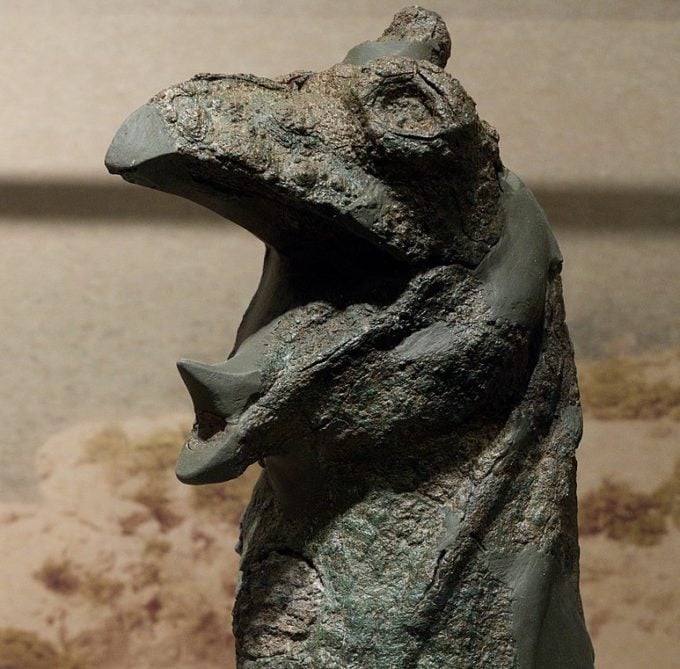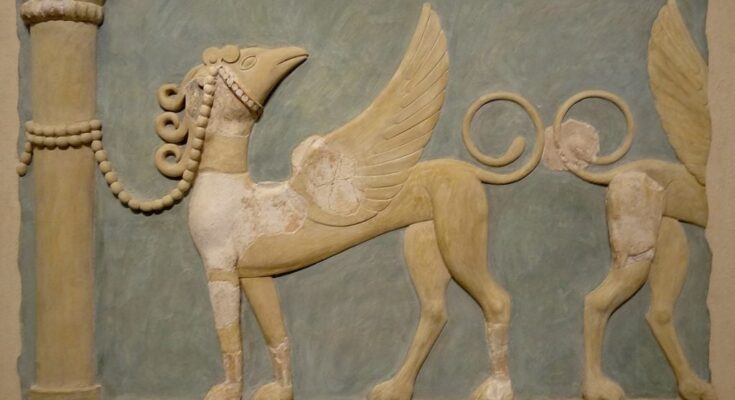Griffins, the unique mythological creatures with the head of an eagle and the body of a lion, were often mentioned in ancient Greek plays.
Also known as Gryps, Grypes, Gryphoi (from the singular form, γρύψ) in ancient Greek, they symbolized strength and bravery.
Griffins were considered noble creatures that lived in the time of ancient Greece and other neighboring regions and protected the rich deposits of gold in the mountains of Scythia, today’s northeastern Europe.
The tribe of griffins that dwelled in the Rhipaean mountains guarding the gold had an enemy, namely their one-eyed neighbors, the Arimaspains, who battled them for these riches.
The Arismaspians used horses to steal the gold and hence arose the enduring hostility that supposedly existed between the horse and the griffin.
Decorative griffins were popular in ancient Greek art and later on in medieval bestiaries and heraldry.
Origins of the creature
The belief of the existence of this monstrous creature suggests that the origin of the myth is somewhere in the East, as variations of a similar creature appeared in Persia and Egypt before 3,000 BC.
Hesiod seems to be the first writer to mention griffins. At a later period, they are listed among the fabulous animals that guarded the gold of India.
The griffin is frequently employed as an ornament in works of ancient art. The earliest record of a griffin is engraved on a bronze dish which the Samians ordered to be made about 640 BC.
Griffins were also sculpted on the helmet of the tall statue of Athena by Phidias which graced the Acropolis around the year 450 BC.
Griffin-type creatures can be found in Minoan art from around the year 1500 BC, as frescoes and reliefs found at Knossos Palace in Crete testify.

Griffins in ancient Greek tragedies and comedies
In Prometheus Bound, by Aeschylus (c. 479 BC) we read the following:
“(Prometheus warns the wandering Io  ‘But now listen to another and a fearsome spectacle. Beware of the sharp-beaked hounds of Zeus that do not bark, the Grypes (Griffins), and the one-eyed (monôpoi) Arimaspoi (Arimaspians), mounted on horses, who dwell about the flood of Plouton’s (Pluton’s) stream that flows with gold. Do not approach them.’”
‘But now listen to another and a fearsome spectacle. Beware of the sharp-beaked hounds of Zeus that do not bark, the Grypes (Griffins), and the one-eyed (monôpoi) Arimaspoi (Arimaspians), mounted on horses, who dwell about the flood of Plouton’s (Pluton’s) stream that flows with gold. Do not approach them.’”
In the comedy Frogs, by Aristophanes (c. 405 BC) there is the following description:
“Euripides : ‘Twas all Skamandros (Scamander), moated camps, and Grypaietoi (Griffin-Eagles) flashing in burnished copper on the shields.”
Herodotus tells of the Griffin
The great historian Herodotus (484-425 BC) wrote in his Histories, Book 3:
“But in the north of Europe there is by far the most gold. In this matter again I cannot say with assurance how the gold is produced, but it is said that one-eyed men called Arimaspoi (Arimaspians) steal it from Grypes (Griffins). The most outlying lands, though, as they enclose and wholly surround all the rest of the world, are likely to have those things which we think the finest and the rarest.”
Also, in Herodotus’ Histories, Book 4, we read:
“Aristeas, possessed by Phoibos (Phoebus) [Apollon], visited the Issedones; beyond these (he said) live the one-eyed Arimaspoi (Arimaspians), beyond whom are the Grypes (Griffins) that guard gold, and beyond these again the Hyperboreoi (Hyperboreans), whose territory reaches to the sea. Except for the Hyperboreoi, all these nations (and first the Arimaspoi) are always at war with their neighbors; the Issedones were pushed from their lands by the Arimaspoi, and the Skythians (Scythians) by the Issedones.”
Again from Histories, Book 4:
“He had in the city of the Borysthenites (in Asia Minor) a spacious house, grand and costly (the same house I just mentioned), all surrounded by Sphinxes and Grypes (Griffins) worked in white marble.”
Another Greek historian of the fifth century, Ctesias, wrote in “Indica,” a record of the view that the Persians held of India:
“There is also gold (in India), not found in rivers and washed, as in the river Paktolos (Pactolus) [in Lydia], but in many large mountains which are inhabited by Grypes (Griffins). These are four-footed birds as large as a wolf, their legs and claws resembling those of a lion; their breast feathers are red, those of the rest of the body black. Although there is abundance of gold in the mountains, it is difficult to get it because of these birds.”
Pausanias wrote about Griffins, as well
Later, the Greek geographer Pausanias (110-180 AD) in his Description of Greece, Book 1 wrote about griffins:
“Grypes (Griffins), Aristeas of Prokonnesos says in his poem, fight for the gold with the Arimaspoi (Arimaspians) beyond the Issedones. The gold which the Grypes guard, he says, comes out of the earth; the Arimaspoi are men all born with one eye; Grypes are beasts like lions, but with the beak and wings of an eagle.”
Pausanias wrote in his Guide to Greece, Book 8:
“I have also heard that Gryphoi have spots like the leopard.”
Also in Pausanias, in Guide to Greece, Book 1:
“At Prasiai (Prasiae) [in Attica] is a temple of Apollon. Hither they say are sent the first-fruits of the Hyperboreoi (Hyperboreans), and the Hyperboreoi are said to hand them over to the Arimaspoi (Arimaspians), the Arimaspoi to the Issedones, from these the Skythians (Scythians) bring them to Sinope, thence they are carried by Greeks to Prasiai, and the Athenians take them to Delos.”
The Greek Geographer Strabo (63 BC-23 AD) wrote about griffins in Geography, Book 8:
“Near the outlet of the river [the River Alpheios in Elis] is the sacred precinct of Artemis Alpheionia . . . In the temple of Artemis Alpheionia are very famous paintings . . . by Aregon the ‘Artemis Borne Aloft on a Gryps (Griffin).’”
The Greek sophist Philostratus (170-247 AD) wrote in the Life of Apollonius of Tyana:
“And the Grypes (Griffins) of the Indoi (Indians) and the Ants of the Aithiopes (Ethiopians), though they are dissimilar in form, yet, from what we hear, play similar parts; for in each country they are, according to the tales of poets, the guardians of gold, and devoted to the gold reefs of the two countries.”
The Modern Revival of Griffins in Popular Culture
Griffins have seen a resurgence in modern culture, appearing in various media and art forms, from fantasy literature to video games. Their representation has evolved, often emphasizing their roles as majestic and powerful guardians in fictional worlds.
- Fantasy Literature and Media: Griffins are frequently featured in fantasy novels, films, and games, where they are depicted as noble creatures with protective instincts.
- Art and Sculpture: Contemporary artists continue to draw inspiration from griffins, creating new works that reinterpret these ancient symbols for a modern audience.
- Cultural Festivals: Some regions with historical ties to griffins have incorporated them into cultural festivals and celebrations, highlighting their enduring legacy.



